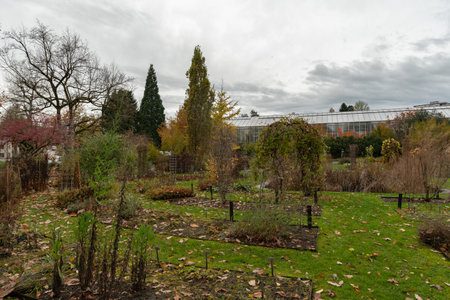Introduction to Raised Bed Vegetable Gardens in the UK
If you stroll through any British neighbourhood, from bustling London boroughs to quaint Cotswolds villages, you’re bound to spot a patchwork of lush green beds brimming with leafy greens and vibrant veggies. These are raised bed vegetable gardens—a cherished staple for many UK families. But what exactly is a raised bed garden, and why has it captured the hearts of gardeners across Britain?
Raised bed gardening involves planting crops in soil that’s elevated above ground level, typically within a frame made of timber, stone, or even recycled materials. This simple innovation has roots deep in the UK’s gardening tradition, echoing the communal spirit of allotments and community plots that have flourished here since wartime days. In fact, much like the beloved British allotment, raised beds foster connection—between family members working side-by-side and with neighbours eager to swap tips or share surplus harvests.
The popularity of raised beds has surged in recent years, as families seek out hands-on ways to grow their own food, teach children about nature, and enjoy the satisfaction of harvesting fresh produce just outside their door. They offer an accessible entry point for both seasoned green thumbs and those new to gardening, making them an ideal choice for anyone looking to make the most of limited outdoor space or unpredictable British weather.
In this comprehensive guide, we’ll explore how raised bed vegetable gardens can transform your growing experience—blending time-honoured British values of community and self-sufficiency with modern best practices for maintenance and bountiful harvests.
2. The Unique Benefits of Raised Bed Gardening in the British Climate
Embracing raised bed gardening in the UK is like inviting a wise old oak into your family—a living companion that adapts to our ever-changing weather and teaches us about resilience and growth. In this land of unpredictable rain showers, brisk spring mornings, and occasional sunbursts, raised beds offer a practical solution for families eager to nurture their own vegetable patch while spending quality time together outdoors.
How Raised Beds Tackle the British Weather
The British climate is famously fickle. One moment, the sky is full of promise; the next, it’s pouring down. Raised beds are perfectly suited to these conditions because they offer:
| Weather Challenge | How Raised Beds Help |
|---|---|
| Heavy Rainfall | Improved drainage prevents waterlogging and root rot. |
| Cool Spring Temperatures | Beds warm up faster than ground soil, giving seedlings a head start. |
| Soil Compaction | Soil remains loose and airy, encouraging healthy root growth. |
| Poor Native Soil | Easily filled with tailored compost blends for optimal fertility. |
A Family-Friendly Growing Environment
For parents and children alike, raised beds create a more accessible and manageable space. The defined edges keep little feet out of delicate plantings, and the soil’s quick drainage means fewer muddy mishaps—perfect for after-school gardening adventures or weekend planting sessions with the kids.
Early Starts and Longer Seasons
Because raised beds heat up quickly in springtime, British gardeners can sow seeds earlier than traditional ground plots allow. This means your children can witness the magic of seeds sprouting right after those chilly March mornings, learning patience as nature reveals her quiet miracles just outside your back door.

3. Choosing the Best Materials and Location for Your Raised Bed
Just as we carefully select the cosiest spot for our children’s bedtime stories, choosing the right materials and location for your raised bed is a tender act of care—one that shapes your garden’s future. Opting for sustainable, UK-sourced materials not only nurtures your patch of earth but also supports local communities. Look for untreated British larch, oak, or Douglas fir, which are naturally durable and safe for growing edibles. Avoid railway sleepers treated with creosote or other chemicals—think of it as keeping your veggie bed as safe as your child’s playpen.
Choosing Eco-friendly Materials
Wood is a traditional favourite, echoing the classic English cottage garden feel. For extra longevity, consider recycled composite boards or bricks reclaimed from nearby demolition projects—each tells its own story, much like family heirlooms passed down through generations. If you prefer a lighter touch, woven willow or hazel hurdles offer natural charm and blend seamlessly into wildlife-friendly spaces.
Location: Making the Most of Limited Sunlight
In the UK, sunlight can be precious—especially in northern regions where long summer evenings are a treasured treat. Place your raised beds where they will catch at least six hours of sunlight per day; south-facing spots are ideal. Watch how the sun moves across your garden throughout the day, much like you’d watch your little ones exploring new corners. Avoid placing beds under large trees or near tall fences that cast persistent shade.
Practical Tips for Positioning
If space is tight, don’t worry! Raised beds can nestle against walls or fences to capture reflected warmth and light—a trick gardeners use for nurturing prized English roses. Consider access too: leave enough room to stroll between beds with a wheelbarrow or to kneel comfortably beside them while weeding together as a family. By thoughtfully choosing materials and positioning your raised beds with love and intention, you lay the foundation for healthy plants—and happy memories spent gardening side by side.
4. What to Grow? Top Vegetables for Raised Beds in the UK
When planning your raised bed vegetable garden, choosing crops that suit both the British climate and your family’s taste buds is key. Raised beds offer a wonderful playground for children to discover the magic of growing their own food, especially when you pick classic UK favourites that are reliable, rewarding, and easy to nurture together.
Family-Friendly Choices: Tried and Tested Favourites
British gardens have long cherished a select group of vegetables for their dependability and deliciousness. Here are some top picks, sure to spark excitement for young gardeners and seasoned green thumbs alike:
| Vegetable | Best Sowing Time | Why Kids Love It | Top Tips for Raised Beds |
|---|---|---|---|
| Carrots | Spring or early summer | Fun shapes and colours; easy to pull up | Choose shorter varieties like ‘Chantenay’; keep soil stone-free for straight roots |
| Broad Beans | Autumn or spring | Podding beans is hands-on fun; sweet flavour when freshly picked | Sow in double rows for support; pinch out tips to discourage blackfly |
| Potatoes | Late winter or early spring (chitting first) | Treasure hunt at harvest time! | ‘First earlies’ are perfect for small spaces and quick results; use deep beds or bags |
| Lettuce & Salad Leaves | Spring through late summer (succession sowing) | Quick results; try different leaf shapes and colours | Mild, moist conditions in raised beds help prevent bolting; cover with netting to deter birds |
| Peas | Spring (from March onwards) | Tasty straight from the pod; easy to train up supports | Add twiggy sticks for climbing; harvest regularly for a longer crop |
| Radishes | Spring through early autumn (succession sowing) | Crisp, colourful, ready in weeks – instant gratification! | Sow thinly and keep well-watered for mild flavour; ideal as a gap-filler between slower crops |
| Courgettes (Zucchini) | Late spring after frost risk passes | See fruits grow rapidly – perfect for little observers! | A single plant can be prolific; give plenty of space and feed regularly for best yields |
The Joy of Growing Together: Little Lessons from Nature
Growing vegetables isn’t just about food—it’s about family time outdoors, patience, and discovery. Children adore being part of the process: poking seeds into soil, watering with miniature cans, then watching shoots unfurl day by day. Carrots surprise with their hidden roots, peas reward careful picking, and potatoes turn harvesting into an exciting dig. These simple moments foster connection not only with nature but also within your own household.
Nurturing Curiosity Through the Seasons
The British weather may be unpredictable, but it’s perfectly suited to these hardy veg. With raised beds offering improved drainage and warmer soil earlier in spring, your family can get started sooner—and stay ahead of the slugs! Rotate crops each year for healthier plants, involve children in planning what goes where, and celebrate each milestone together: the first sprout, the tallest bean stalk, or the crunchiest radish.
A Gentle Invitation from the Garden: “Come outside—let’s see what’s growing today!”
Your raised bed can become a living classroom and a source of shared joy. Choose local favourites, grow them side by side with your young helpers, and enjoy feasts flavoured with pride and laughter—right from your own patch of British soil.
5. Seasonal Maintenance and Care for Healthy Raised Beds
Ensuring your raised bed vegetable garden thrives across the changing British seasons is a delightful dance that echoes the gentle rhythms of our countryside. With a little planning and involvement from even the smallest green thumbs, these tasks become not only manageable but also memorable family moments.
Spring: Awakening the Beds Together
As daffodils begin to nod in the hedgerows, it’s time to clear away winter debris. Children can help gently remove old leaves and tidy up spent plants—an excellent way to teach respect for new beginnings. Together, loosen the soil with hand forks, readying it for fresh sowings. Show young helpers how to sprinkle compost, feeding the earth as you would nurture each other.
Summer: Watering and Watching Growth
Longer days mean more sun—and thirsty plants. Invite your children to take turns watering, teaching them to check if the soil feels dry before giving it a drink. Early morning or evening watering helps conserve moisture, just as British rain showers do. Encourage observation: whose sunflower is tallest? Which pea pod is plumpest?
Autumn: Harvesting and Preparing for Rest
The golden light of autumn invites reflection and gratitude. Little hands can help gather ripe vegetables, learning to harvest with care. As beds empty, involve children in spreading mulch or leaf mould to protect the soil through winter—nature’s own blanket. Collect seeds together for next year, marvelling at the circle of life.
Winter: Gentle Care and Dreaming Ahead
Raised beds benefit from rest, too. Inspect for frost damage or waterlogging after heavy British rains—tasks perfect for curious eyes. Covering beds with hessian or fleece is a simple activity for children on crisp mornings. Use this quieter season to dream up next year’s planting plan over a cup of cocoa, encouraging ideas and curiosity.
Simple Family-Friendly Tasks All Year Round
Throughout every season, basic maintenance like weeding can be made fun by turning it into a game—who can find the longest root? Regularly check for pests together, teaching gentle methods such as picking off slugs or attracting birds with homemade feeders. These small acts foster responsibility and wonder in growing minds.
Cultivating Bonds Alongside Vegetables
Tending raised beds isn’t just about nurturing vegetables—it’s about cultivating patience, teamwork, and an appreciation for nature’s cycles. By sharing these seasonal tasks with your children, you’re sowing seeds of connection that will flourish far beyond your garden gate.
6. Common Challenges and How to Overcome Them
Staying Resilient Together: Facing Slugs, Frosts, and Foxes
Even the most well-tended raised bed gardens in the UK can encounter their fair share of hurdles. But just as the wild British hedgerows withstand storms and curious creatures, your family garden can flourish with a bit of teamwork, patience, and clever strategies.
Tackling Tenacious Slugs
Slugs are notorious guests in our damp British climate, often munching on tender seedlings. To keep them at bay, consider surrounding your beds with copper tape—a solution many local gardeners swear by. Evening slug patrols can become a family ritual; little hands love searching for these sneaky visitors! Encourage gentle relocation rather than squishing, teaching children about respecting all life in the garden ecosystem.
Managing Unpredictable Frosts
Our weather can turn chilly unexpectedly, especially in spring and autumn. To protect young plants, keep a stash of horticultural fleece or old net curtains handy for quick cover-ups. Involve your children by letting them help tuck the beds in at night—much like tucking themselves into bed! Discuss how British wildlife survives winter, drawing inspiration from hedgerow plants that shelter beneath leaves and branches.
Outsmarting Urban Foxes
Clever foxes are common visitors in UK towns and cities, sometimes digging up beds in search of worms or food scraps. Sturdy mesh covers or temporary fencing can deter their explorations. Make it a fun project to build “fox-proof” barriers together using recycled materials, sparking creativity and teamwork. Remind your young gardeners that foxes are part of our urban wildlife tapestry—observing their tracks can be an exciting mystery to solve as a family!
The Power of Family Teamwork and Persistence
Gardening is rarely perfect—there will always be surprises along the way. Share stories about resilient hedgerows that bounce back after storms or nibbles from animals. Celebrate small victories together: a slug-free lettuce, frost-safe seedlings, or outsmarting a cunning fox. By working as a team and embracing each challenge as an adventure, you’ll nurture not only strong vegetables but also enduring family bonds—rooted in patience, problem-solving, and the timeless lessons found just outside your door.
7. Connecting with Your Community and Nature
One of the most rewarding aspects of raised bed vegetable gardening in the UK is how it can bring families closer together—not just within your own household, but also as part of your wider community. Gardening in Britain has long been a cherished tradition, woven into the fabric of our villages, towns, and cities. By embracing this heritage, you and your family can deepen your connection to nature and strengthen bonds with those around you.
Joining Local Gardening Groups
Get involved in your local allotment association or community gardening group. These spaces are filled with friendly faces ready to share advice, lend tools, or offer a helping hand when you need it most. Many groups organise seasonal events such as plant swaps, harvest festivals, and open garden days—perfect opportunities for children to see how others tend their plots and to learn about regional plant varieties that thrive in your area.
Swapping Seeds and Stories
The age-old British tradition of swapping seeds isnt just practical—it’s a wonderful way to keep old varieties alive and introduce new favourites into your raised beds. Children will delight in exchanging sunflower seeds or runner beans they’ve saved from last year’s crop with neighbours down the road. As you swap, stories often follow: tales of bumper harvests, cheeky squirrels, or memories of gardens gone by. These moments knit families together, creating a shared tapestry of gardening wisdom.
Learning from Neighbours
Your neighbours are one of your best resources. Perhaps there’s a seasoned gardener on your street who knows the secret to growing perfect carrots in heavy clay soil or an elder who can teach your little ones how to spot early signs of blight. By inviting advice—and offering help in return—you foster a true spirit of community where everyone benefits.
Celebrating British Traditions Together
Why not mark the changing seasons with classic British traditions? Host a tea party among your raised beds at midsummer, or take part in apple day festivities come autumn. Encourage your children to enter the village vegetable show or take pride in contributing homegrown produce to a local food bank. Each activity helps root your family in both nature and neighbourhood life.
Through these simple yet meaningful connections—with each other, your community, and the natural world—your raised bed vegetable garden becomes more than just a place for plants; it becomes a vibrant hub of learning, sharing, and togetherness that will grow alongside your family for years to come.


